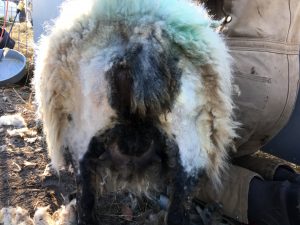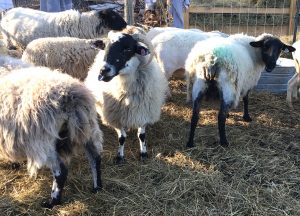We’re coming up on the start of lambing this week!
It’s a very exciting time, with scrambling to make sure my lambing kit is fully stocked as well keeping an exceptionally close eye on the soon-to-be mothers. Making sure they have constant access to minerals that have iodine and vitamin E and selenium are very important to prevent certain conditions, such as white muscle disease (caused by low selenium), which is essentially similar to muscular dystrophy in its effects on lambs.
The ewes have been getting ¼ lb of corn for the last 5 weeks now. We will continue that until they lamb, at which time we will increase that from anywhere to ½ lb to 1 lb a day. This is done while they are lactating to increase milk production and vitality of the lamb. It also helps to keep the ewe from losing too much weight while she’s feeding lambs. The more lambs she has, the more corn she gets as well.
Roughly 70% of lamb growth in the womb occurs during the last 4-6 weeks a ewe is pregnant. That takes a lot of energy from the ewe to make happen! Feeding high-energy corn (which has good protein and energy easily used by the ewe) prevents or helps prevent what’s called Pregnancy Toxemia, or ketosis. This is when the ewe starts burning muscle instead of fat to grow her babies; this is obviously very bad. A ewe with ketosis can die within a couple hours of symptoms becoming visible. I prefer proactive rather than reactive methods of treating, particularly when you can prevent the condition largely through a well planned diet.
Two weeks ago, the ewes and rams got their annual booster shots of CDT vaccine. By giving their booster at this stage of pregnancy, we hope some protection passes to the lambs through colostrum.
Quick definition of Colostrum: All mammals that bare live young produce colostrum. It is thick, yellowish “first milk” that is produced by the ewe after she gives birth. Colostrum is rich in energy, protein, vitamins and minerals. More importantly, it contains maternal antibodies that help protect the newborn from disease pathogens during the early part of its life. Ewes only produce colostrum for about 24 hours after delivering their lambs.
The types of antibodies the colostrum contains depend upon the antigens to which the ewe was exposed to (by disease exposure or vaccination). Ewes should be vaccinated in late pregnancy for overeating disease (clostridium perfringins type C & D) and tetanus (clostridium tetani) so that they will pass antibodies for these diseases to their offspring via the colostrum.
Because I run a mixed hair and wool flock, I also need to strategically shear my wool ewes’ backsides, also known as crutching the ewe. This is the process of shearing the wool along the legs and backsides (vulva and rectum area) as well as cleaning the udder area free of wool. Crutching makes it easier and more sanitary for the lamb to be born while preserving the rest of the fleece for shearing time later in the spring, once the risk of freezing temps have past, and makes it easier for the lamb to find the teats quickly for a robust first drink.


Let’s take a look inside my lambing kit:
- Rubber gloves, short ones and OB length
- Disinfectant for your hands
- Iodine/Betadine
- Thermometer
- Needles and syringes
- Heat lamp just in case
- Milk replacer
- Propylene glycol
- Suturing needles (you never know when you’ll need to stitch something)
- Hemostats (I like the curved ones best)
- Scale and weight sling. Taking first weights is very important for records
- Ear tags and applicator
- Docking and castrating bands and applicator

Lambing jugs are also being readied. They are 4×4 or 5×5 pens that allow the ewe and lambs to get to know each other better. Creating a solid bond between ewe and lambs is vital for their survival. You don’t want an iffy mother to suddenly reject a day old lamb. Bottle-feeding lambs is hard work for the shepherd while lambing is going on, and they don’t thrive as well on formula as good, wholesome sheep’s milk.
Each ewe with her lamb or lambs will stay in the lambing jugs for 24-72 hours. The more lambs she has, the longer she stays in to get that bond. This allows the shepherd to keep good tabs on the ewes and lambs to see them drinking and peeing.
(Worrying about the consistency of poop in all forms is something I never knew I’d need to know! File that under the, well now I do and can talk extensively to others about! Lucky you!)
Once the ewes come out of the lambing jugs, they go into a bigger holding area to mingle with their fellow sheep. The lambs learn which of the mamas is theirs, and not to try and steal milk! That’ll be a swift light head butt to the side if they do that!
Eventually the ewes and lambs are all together back in their full sized flock, with many additions! They all then move to a fully rested (2-4 month long) paddock to play and grow, and be adorable bouncy baby sheep.
At 2-4 weeks old the lambs then get their first CDT shots, then again in two weeks. They’ve already had their tails docked, rams have been banded, and ear tags placed in for identification purposes. Also allows us easy to figure out which lambs belong to which ewes.
Throughout this process the lambs will have 24/7 access to a creep feeder. There they get their own supply of minerals and a high protein grower feed.
At 8 weeks old the lambs are weaned from their loving mothers, and they’ll go into a pen all to themselves, out of sight of the ewes. Lot’s and lot’s of yelling commences, day in and out for a couple days. Here they will continue to get creep feed and their own hay. We will weigh them at certain time intervals to see which ones are growing well, make notations about them and their mothers for future breeding decisions.
Ewe lambs will be marketed as either replacement stock for purebred flocks, kept to better my own flock, or culled with the wether lambs if they don’t fare well enough to belong in a breeding flock. Wether lambs (castrated ram lambs) will be marketed as meat lambs (I know I know, how can I eat my own sheep? As I joke, one bite at a time!), I will keep a few for direct package sales off the farm, as well as a few people I have that want to purchase live on the hoof and take the animal themselves to the processor to get just what they want cut wise. Then I’ll send the rest to auction.
While all this is going on with the lambs, the ewes are also still getting special attention.The first 24-48 hours after I wean the lambs from them, they go into a pen with low quality hay to try and dry up the ewes as quickly as possible. We don’t want them to ever get mastitis in their udders, so this is a process we monitor very closely. After about a week, if they’re drying up well, they get to be back in their nice comfy pasture, still with the lower quality hay until they’ve completely dried up and the udder has shrunk considerably. They get to enjoy the summer out, or in the case of the hair sheep, some of the exceptional producers will be rebred for fall/winter lambing. Wool sheep are hard to get to rebreed out of season so we let them have their natural cycle.
All in all I think I’ve got a decent hold on lambing time. When the month is done and you can stand in your pasture and actually see what you’ve helped bring into the world, it’s a great day. The hours of missed sleep from every two hour checks in the middle of the night, the constant attention given to new born lambs to make sure they’ve latched onto the teat well, it’s all worth it. Every exhausted, painstakingly patient, backbreaking moment.